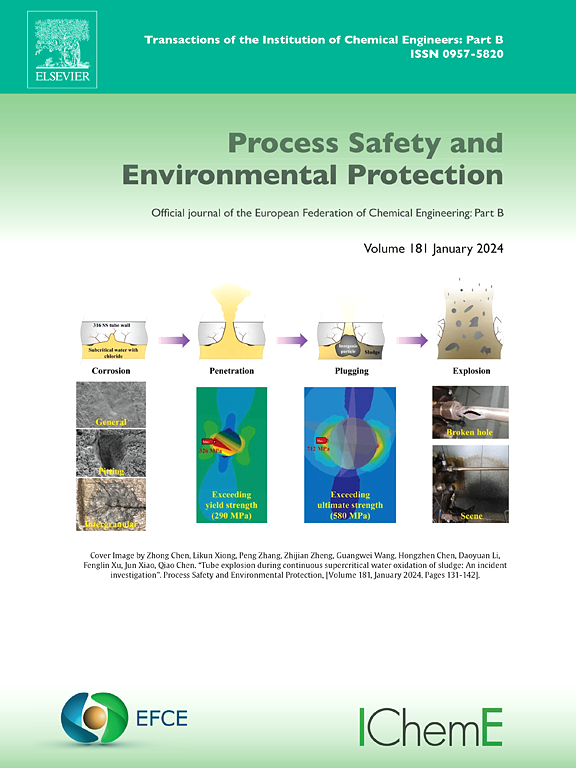Multi-coupling fault detection and diagnosis of photovoltaic arrays with improved slime mould algorithm and PolyCatBoost
IF 6.9
2区 环境科学与生态学
Q1 ENGINEERING, CHEMICAL
引用次数: 0
Abstract
Photovoltaic (PV) system, integral to the renewable energy landscape, occupies a pivotal role within the modern energy frameworks. With the rapid development of PV technology, timely and precise fault diagnosis of PV arrays has become particularly significant. However, the performance of fault diagnosis model is seriously affected by the data imbalance that usually exists in PV arrays. To address this, a novel fault detection and diagnosis method that integrates an improved slime mould algorithm (ISMA) with a CatBoost model based on polyloss function (PolyLoss-CatBoost, PolyCatBoost). Firstly, according to PV modeling, the multi-coupling fault features are extracted with fault type identification. Moreover, the PolyCatBoost fault diagnosis model is established for imbalance data, and the ISMA algorithm is utilized for optimizing the model parameters to achieve accurate compound faults diagnosis. Finally, through experiment comparisons, the imbalanced classification evaluation metrics, UAR, MCC, and Hamming loss, reach to 0.858, 0.817, and 0.026, respectively. It indicates that the proposed model performs exceptionally well under data imbalance conditions. Besides, the accuracy is close to 95 % under noisy conditions, which verifies the superiority of the proposed method in terms of diagnosis accuracy, robustness and stability.
基于改进黏菌算法和PolyCatBoost的光伏阵列多耦合故障检测与诊断
光伏(PV)系统是可再生能源领域不可或缺的一部分,在现代能源框架中占有举足轻重的地位。随着光伏技术的快速发展,对光伏阵列进行及时、精确的故障诊断变得尤为重要。然而,光伏阵列中通常存在的数据不平衡问题严重影响了故障诊断模型的性能。针对这一问题,一种新型故障检测和诊断方法将改进的粘模算法(ISMA)与基于多损失函数的 CatBoost 模型(PolyLoss-CatBoost,PolyCatBoost)相结合。首先,根据光伏建模,提取多耦合故障特征,并进行故障类型识别。然后,针对不平衡数据建立 PolyCatBoost 故障诊断模型,并利用 ISMA 算法优化模型参数,实现准确的复合故障诊断。最后,通过实验比较,不平衡分类评价指标 UAR、MCC 和 Hamming loss 分别达到 0.858、0.817 和 0.026。这表明所提出的模型在数据不平衡的条件下表现优异。此外,在噪声条件下的准确率接近 95%,这验证了所提方法在诊断准确性、鲁棒性和稳定性方面的优越性。
本文章由计算机程序翻译,如有差异,请以英文原文为准。
求助全文
约1分钟内获得全文
求助全文
来源期刊

Process Safety and Environmental Protection
环境科学-工程:化工
CiteScore
11.40
自引率
15.40%
发文量
929
审稿时长
8.0 months
期刊介绍:
The Process Safety and Environmental Protection (PSEP) journal is a leading international publication that focuses on the publication of high-quality, original research papers in the field of engineering, specifically those related to the safety of industrial processes and environmental protection. The journal encourages submissions that present new developments in safety and environmental aspects, particularly those that show how research findings can be applied in process engineering design and practice.
PSEP is particularly interested in research that brings fresh perspectives to established engineering principles, identifies unsolved problems, or suggests directions for future research. The journal also values contributions that push the boundaries of traditional engineering and welcomes multidisciplinary papers.
PSEP's articles are abstracted and indexed by a range of databases and services, which helps to ensure that the journal's research is accessible and recognized in the academic and professional communities. These databases include ANTE, Chemical Abstracts, Chemical Hazards in Industry, Current Contents, Elsevier Engineering Information database, Pascal Francis, Web of Science, Scopus, Engineering Information Database EnCompass LIT (Elsevier), and INSPEC. This wide coverage facilitates the dissemination of the journal's content to a global audience interested in process safety and environmental engineering.
 求助内容:
求助内容: 应助结果提醒方式:
应助结果提醒方式:


